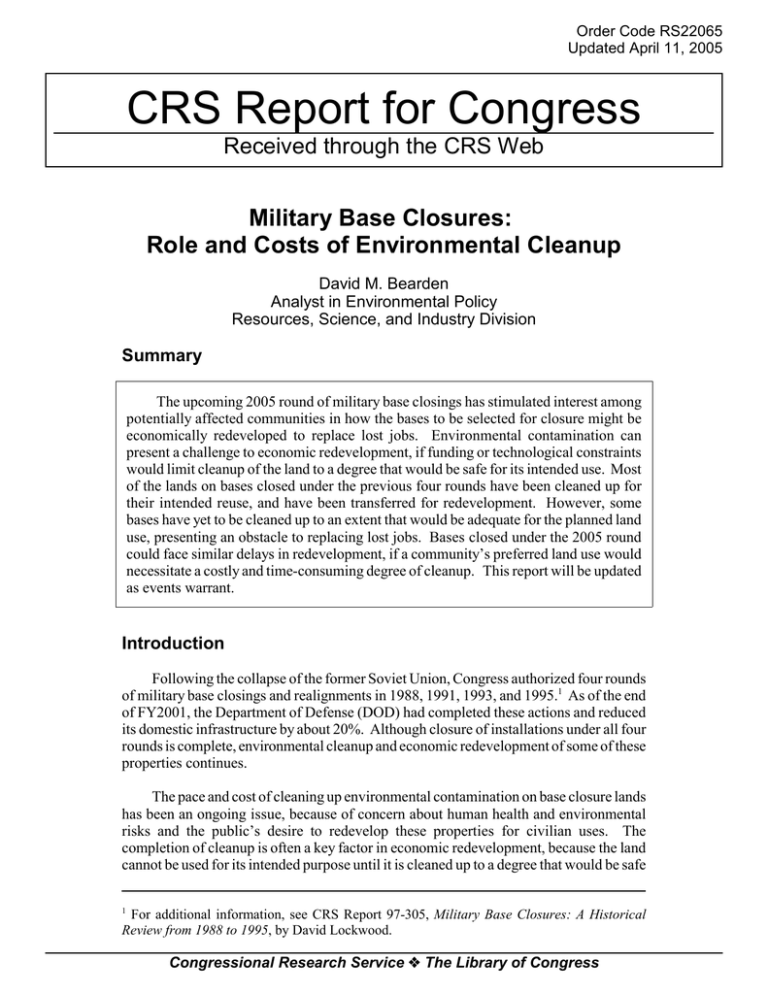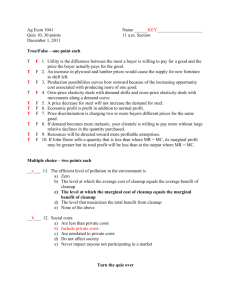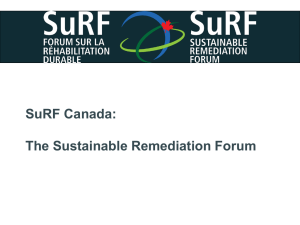CRS Report for Congress Military Base Closures: Received through the CRS Web
advertisement

Order Code RS22065 Updated April 11, 2005 CRS Report for Congress Received through the CRS Web Military Base Closures: Role and Costs of Environmental Cleanup David M. Bearden Analyst in Environmental Policy Resources, Science, and Industry Division Summary The upcoming 2005 round of military base closings has stimulated interest among potentially affected communities in how the bases to be selected for closure might be economically redeveloped to replace lost jobs. Environmental contamination can present a challenge to economic redevelopment, if funding or technological constraints would limit cleanup of the land to a degree that would be safe for its intended use. Most of the lands on bases closed under the previous four rounds have been cleaned up for their intended reuse, and have been transferred for redevelopment. However, some bases have yet to be cleaned up to an extent that would be adequate for the planned land use, presenting an obstacle to replacing lost jobs. Bases closed under the 2005 round could face similar delays in redevelopment, if a community’s preferred land use would necessitate a costly and time-consuming degree of cleanup. This report will be updated as events warrant. Introduction Following the collapse of the former Soviet Union, Congress authorized four rounds of military base closings and realignments in 1988, 1991, 1993, and 1995.1 As of the end of FY2001, the Department of Defense (DOD) had completed these actions and reduced its domestic infrastructure by about 20%. Although closure of installations under all four rounds is complete, environmental cleanup and economic redevelopment of some of these properties continues. The pace and cost of cleaning up environmental contamination on base closure lands has been an ongoing issue, because of concern about human health and environmental risks and the public’s desire to redevelop these properties for civilian uses. The completion of cleanup is often a key factor in economic redevelopment, because the land cannot be used for its intended purpose until it is cleaned up to a degree that would be safe 1 For additional information, see CRS Report 97-305, Military Base Closures: A Historical Review from 1988 to 1995, by David Lockwood. Congressional Research Service ˜ The Library of Congress CRS-2 for reuse. DOD is scheduled to release its recommendations for another round of base closings and realignments in May 2005, subject to review by a specially appointed commission, and approval by the President and Congress.2 The upcoming round has raised concern among communities as to whether the cleanup of environmental contamination may pose challenges in redeveloping additional bases to replace lost jobs. This report provides an overview of cleanup requirements for the transfer and reuse of base closure properties, discusses the status of property transfer on bases closed under the four previous rounds, examines past cleanup costs and estimates of future costs, and offers relevant observations for the upcoming 2005 round. Cleanup Requirements for Property Transfer and Reuse Section 120(h) of the Comprehensive Environmental Response, Compensation, and Liability Act (CERCLA, commonly referred to as Superfund) generally requires the United States (in this case, DOD) to clean up closed bases prior to transfer out of federal ownership.3 Property on a closed base is typically transferred to a local redevelopment authority (LRA) responsible for implementing a plan for civilian reuse. To speed redevelopment, CERCLA authorizes early transfer under certain conditions.4 For bases on the National Priorities List (NPL) of the nation’s most hazardous waste sites, early transfer requires the concurrence of DOD, the Environmental Protection Agency (EPA), and the governor of the state in which the property is located. For bases not on the NPL, concurrence of only DOD and a governor is required for early transfer. Early transfer can be advantageous in terms of redevelopment, if the intended land use would not present the potential for human exposure to contamination, and therefore not require cleanup. Conversely, redevelopment still could be delayed despite early transfer, if cleanup would be necessary to make the intended land use safe. Whether a property is transferred after cleanup, or transferred early, the degree of cleanup can vary from site to site, depending on the cleanup standard used and the remedy selected to attain it. CERCLA does not specify cleanup standards for particular substances. Rather, it requires that cleanup comply with all legally applicable, relevant and appropriate requirements (ARARs) to protect human health and the environment, which include a host of federal and state standards for various hazardous substances.5 CERCLA does not explicitly require the consideration of land use in determining the degree of cleanup. However, in practice, land use is a key factor in deciding which 2 For information on the criteria that DOD is using to select bases for the 2005 round, see CRS Report RS21822, Military Base Closures: DOD’s 2005 Internal Selection Process, by Daniel Else and David Lockwood. For information on the status of the 2005 round, see CRS Report RL32216, Military Base Closures: Implementing the 2005 Round, by David Lockwood. 3 42 U.S.C. 9620(h) 4 42 U.S.C. 9620(h)(3)(C) 5 42 U.S.C. 9621(d) CRS-3 cleanup standard is used, and what remedy is selected to attain it. Cleanup standards generally are stricter for land uses that would result in greater risk of human exposure to contamination. For example, cleanup is typically more stringent and more costly for land uses such as residential development, which could pose a higher risk of exposure to sensitive populations including children and the elderly. Cleanup is typically the least stringent and the least costly for industrial land uses, such as manufacturing, which could pose less risk of exposure. EPA, or the overseeing state agency, is responsible for determining whether the selected remedy would attain the cleanup standard for a specific site.6 EPA has issued non-binding guidance for considering the “reasonably anticipated land use” in selecting cleanup remedies.7 DOD and the community, usually through the LRA, are responsible for determining how the land will be reused, in negotiating the terms of the property transfer. However, the community’s ability to attain its preferred use is constrained, as the Defense Base Closure and Realignment Act does not require DOD to dispose of property on a closed base for a particular land use, nor within a certain time frame.8 Impediments to conveying the land for redevelopment may surface if DOD is resistant to transferring it for a purpose that the community desires because of cost considerations or technological limitations affecting cleanup of the contamination. EPA’s guidance, noted above, acknowledges that some land uses may not be practical due to such challenges, and indicates that the cleanup objective may need to be revised, which may result in “different, more reasonable land use(s).”9 In addition to land use, numerous other factors can determine the degree and cost of cleanup, raising further issues. For example, cleanup does not necessarily require the removal of contamination, if a safe method of containing it is available to prevent exposure. Although containment is typically less costly than removal, some of the savings of containment can be offset by the costs of maintaining the containment method over the long term to ensure that it remains effective in preventing exposure. Tensions may arise between DOD and the community, if there is disagreement over the method selected to prevent exposure. Communities frequently prefer removal rather than containment, because of concerns about lingering risks and continuing costs if the method of containment were to fail over time. However, DOD may prefer containment to save costs, due to limited funding for the cleanup of many closed bases across the country. 6 Both EPA and states play a role in the oversight of cleanup on federal facilities, including military installations. EPA typically is the lead agency at sites listed on the NPL, and states usually take the lead on those that are not listed on the NPL. 7 EPA. Office of Solid Waste and Emergency Response. Land Use in the CERCLA Remedy Selection Process. OSWER Directive No. 9355.7-04. May 25, 1995. 8 9 10 U.S.C. 2687 note EPA. Office of Solid Waste and Emergency Response. Land Use in the CERCLA Remedy Selection Process. OSWER Directive No. 9355.7-04. May 25, 1995. p. 7. CRS-4 Once a land use is agreed upon between DOD and the community, and a cleanup remedy is selected to make it safe for that land use, DOD generally administers and pays for the cleanup, regardless of whether cleanup is completed prior to transfer, or subsequently under an early transfer. In the case of an early transfer, the property recipient may choose to administer the cleanup as a means to speed the reuse of the land, but DOD typically would still pay the costs. DOD remains obligated after cleanup is complete, if additional contamination is found later that requires remediation. However, DOD is obligated for further cleanup only to the extent that the degree of contamination found later would exceed applicable standards for the land use originally agreed upon for the transfer. If a community decides to use the land for another purpose that would require further cleanup, DOD would not be responsible for paying for it. In such cases, the additional costs of cleanup to make the land safe for a different purpose would be the responsibility of the property recipient. Status of Property Transfer on Closed Bases10 The Government Accountability Office (GAO) reports that, as of the end of FY2003, 364,000 acres (72%) of the 504,000 acres of land on bases closed during the previous four rounds had been transferred for reuse. Approximately 95% of the transferred acreage had been transferred after cleanup was completed. Although early transfer has the potential to speed redevelopment, it has been used relatively infrequently for several reasons, such as the reluctance of a community to accept property before cleanup is finished and the lack of consensus within a community on reuse. DOD also may be hesitant to agree to early transfer if it would be required to expend more cleanup funds earlier than would be necessary otherwise, to make the land safe for reuse more quickly. Approximately 91,000 acres (18%) on closed bases had been leased for reuse prior to the completion of cleanup. However, pending cleanup has delayed the permanent transfer of these properties, with reuse limited to purposes that would be safe considering the degree of contamination still present on these lands and the potential risk of human exposure. The remaining 49,000 acres (10%) had not been leased or transferred for reuse primarily because of environmental cleanup challenges. GAO found that some cleanup is necessary before transfer can occur on 98% of Air Force, 82% of Army, and 65% of Navy lands still awaiting transfer. Past Cleanup Costs and Estimates of Future Costs11 DOD estimates that the closure of bases under the previous four rounds has resulted in an annual savings of $7 billion in operational expenses. The costs of environmental cleanup have run into billions of dollars, discussed below, and have offset some of these savings gained from a reduced military infrastructure. However, a portion of the cleanup costs would have been incurred regardless, as DOD is required to clean up its operational 10 Government Accountability Office, Military Base Closures: Updated Status of Prior Base Realignments and Closures, GAO-05-138, January 2005. See pp. 10-19. 11 Based on CRS compilation of cost data from DOD’s Defense Environmental Restoration Program Report to Congress for FY2003, April 2004. CRS-5 installations at least to a degree that would be safe for military uses, somewhat reducing this offset. The incremental cost and time to clean up a closed base depends primarily on how extensive the cleanup must be to make the land safe for uses that would be less restrictive than military purposes, and pose a higher risk of human exposure. As presented in the following table, DOD data indicate that $7.2 billion in cleanup costs had been incurred through FY2003 at bases closed during the previous four rounds. This amount reflects the actual costs of the cleanup process, from site identification and investigation to selection, design, construction, operation, and monitoring of cleanup remedies. About 42% of the $7.2 billion was spent on cleanup in California, where DOD has identified more contaminated sites on closed bases than any other state. In January 2005, GAO reported $8.3 billion in cleanup expenses at closed bases through the end of FY2003. This amount reflects funding obligated for cleanup, some of which would be paid at a later date upon completion of specific cleanup actions, rather than actual costs incurred through this period. GAO’s reported amount also includes other costs related to cleanup, such as program management and support. Although the majority of the acreage on bases closed under the previous four rounds has been cleaned up and transferred, estimates of future costs to complete cleanup on lands awaiting transfer, and on those transferred early, remain substantial. Also noted in the following table, DOD data indicate that an estimated $3.7 billion would be necessary to complete cleanup of known contamination on these lands, with 51% of these costs attributed to cleanup in California. However, future costs could be higher than estimated, if new, or more stringent, regulations are issued that require a greater degree of cleanup than anticipated. Future costs also could be more than expected if unknown environmental threats, such as unexploded ordnance or additional hazardous substances, are discovered. On the other hand, costs at some sites may prove lower if more cost-effective cleanup technologies become available. The President’s FY2006 budget includes $378 million for continuing cleanup at bases closed under the previous four rounds, $112 million more than the FY2005 appropriation of $246 million. Relevant Observations for the Upcoming 2005 Round The amount of money and time required to clean up additional bases to be selected for closure in the 2005 round would depend on the type and extent of contamination present on those properties, and the actions that would be necessary to make the land safe for reuse. As in prior base closure rounds, the availability of funding and the capabilities of remediation technologies could limit the degree of cleanup of some properties, making certain land uses infeasible and posing challenges to economic redevelopment. Consequently, communities concerned about the possible closure of a base in their area would be better positioned to develop an effective plan for economic redevelopment if they are knowledgeable about the contamination on that base and the potential funding and technological limitations that DOD may encounter in cleaning it up for alternative land uses. Cleanup at a base that is currently active may already be underway, with the degree of cleanup based on the continued military use of the property. If such a base were selected for closure, greater funding and time than DOD has planned may be required to complete the cleanup and make the land suitable for less restrictive uses. CRS-6 Environmental Cleanup Costs from Previous Base Closure Rounds State or U.S. Territory Alabama Alaska Arizona Arkansas California Colorado Connecticut Florida Guam Hawaii Illinois Indiana Iowa Kentucky Louisiana Maine Maryland Massachusetts Michigan Midway Islands Missouri Montana Nebraska New Hampshire New Jersey New Mexico New York North Carolina Ohio Oregon Pennsylvania Puerto Rico Rhode Island South Carolina Tennessee Texas Utah Virginia Washington Total Past Costs Incurred Through FY2003 $227,624,000 $260,731,000 $67,743,000 $60,208,000 $3,067,651,000 $205,465,000 $18,320,000 $146,693,000 $171,855,000 $58,130,000 $283,076,000 $83,951,000 $6,779,000 $47,107,000 $34,072,000 $129,560,000 $120,720,000 $312,939,000 $111,995,000 $21,978,000 $12,589,000 $813,000 $195,000 $153,393,000 $104,583,000 $34,397,000 $245,016,000 $95,000 $40,184,000 $53,560,000 $187,227,000 $486,000 $51,723,000 $103,354,000 $57,098,000 $495,862,000 $163,642,000 $68,881,000 $16,301,000 $7,225,996,000 Estimates of Future Costs FY2004 to Completion $124,969,000 $47,407,000 $44,921,000 $1,888,000 $1,885,967,000 $80,224,000 $21,857,000 $43,764,000 $48,351,000 $10,178,000 $190,477,000 $37,520,000 $0 $4,113,000 $16,684,000 $104,719,000 $26,895,000 $49,693,000 $56,419,000 $0 $1,352,000 $0 $0 $50,750,000 $34,004,000 $37,973,000 $162,400,000 $0 $6,654,000 $10,290,000 $44,404,000 $6,304,000 $12,973,000 $20,987,000 $35,648,000 $371,129,000 $77,992,000 $7,793,000 $1,439,000 $3,678,138,000 Source: Prepared by CRS using data from the Department of Defense, Defense Environmental Restoration Program Report to Congress for FY2003, April 2004. The above total amount of $7.2 billion through FY2003 for all states and territories reflects actual costs of cleaning up contaminated lands on bases closed under the four previous rounds combined. Planned cleanup is complete in states with no estimated future costs. In January 2005, GAO reported a total of $8.3 billion through FY2003 in funding obligations for environmental cleanup at base closure sites, which includes costs to be paid at a later time when specific actions are complete, and other costs such as program management and support.




